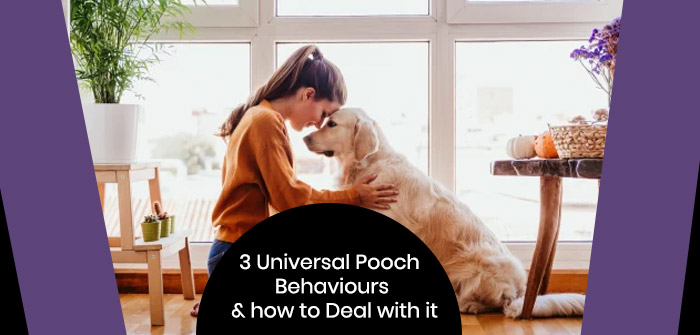3 Universal Pooch Behaviours and how to Deal with it
Being a dog owner is not an easy task as you need to constantly upgrade yourself to learn about your canine including their behaviour towards different things. It can include decoding their body language, postures, actions and vocalizations. Note: This is not an easy task by any means. On top of it your canine can behave differently depending on the environment they are in. So your pooch has the ability to understand the situation and depending on that they take into clues the surroundings and then behave accordingly.
Since we are talking about dogs, it is important to note that they too depict the same types of emotions like we human beings do. This includes feelings of fear, contentment, pain and joy. So it becomes very intricate to determine whether your dog is showing aggression, anxiousness or affection towards you. Let us look at different emotions that will happen you determine through their body language what they are trying to convey to you:
Warmth and love
Different non-verbal clues depicted by your pooch: Your pooch would convey their emotions about love towards you by kissing your face or hand. They even sometimes wag their tales in a laid back circular rhythm or flipping over to showcase their bellies. Pooches have the habit of following their owners from room to room, especially if they want to show their warmth and love towards you. They even greet you when you enter the front door as if you are a rock star.
How to deal with it?: You can respond to this behaviour of pooch by greeting them with their name in a friendly manner. Give undivided attention to your pooch by conducting one-minute session with them. In that session make sure that your pamper him and showcase that they are very special to you. This will make them feel very happy and their love and warmth towards you will grow significantly.
Violent behaviour
Different non-verbal clues depicted by your pooch: Your pooch will depict violent behaviour when they are fearful of something, when they want to protect their resources, if they are suffering from pain due to any medical condition or injury or if someone tries to enter their territory. Pooches have the tendency to give warning signals when they are in pain or the ire of something before they bite or lung towards someone. You need to verify whether their muscles are getting tensed, or if their ears are flattening out or forwarding. If they stare at you persistently or reveal their teeth by lifting their upper lip or if their hair are raised on the spine with their body leaning forward then it shows that they are going to depict violent behaviour. They may even snarl or grow that you if they want to depict aggression.
How to deal with it?: If you find any of the non-verbal clues mentioned above in a dog never approach them. He is clearly showing a “back off” message which needs to be taken seriously. If your normally sweet dog suddenly shows violent behaviour at his food bowl or while chewing a bone, then it shows that he is trying to protect his resource. This can be corrected with behaviour modification techniques. The best thing to do in such a situation is to help from a professional dog trainer who would give you tips on correcting this potentially dangerous behaviour in dogs. If you hit an aggressive dog who is depicting violent behaviour, it will escalate this behaviour and will cause a friction between your relationship with him. He may even start mistrusting you.
Anxiousness
Different non-verbal clues depicted by your pooch: There are times when dogs dislike a particular situation which is never in their control which causes anxiousness in them. It can be as simple as a visit to the veterinarian. Your pooch may try to hide from you, vocalize or even pant or whine when faced with a situation that they do not like. It can also cause fear in them, which may be depicted by pacing, tucking their tails, trembling, avoiding eye contact, yawning, blinking too much and hug tightly a trusted person.
How to deal with it?: In order to curb their anxiousness sometimes your veterinarian would prescribe anti-anxiety treatments in combination with behavior modification techniques that would make your anxious pooch feel safe. Never speak in a baby or cooing tone with your pooch as it can lead to more nervousness and anxiousness in your pooch. Train the pooch by teaching him to sit and stay in a fixed spot and reward him with a healthy treat and affection whenever he obeys your order. If the dog is not acclimated to other family members ask them to shower love and affection towards the pooch. You will also have to see that the pooch responds positively to any changes that occur in the household routine.


